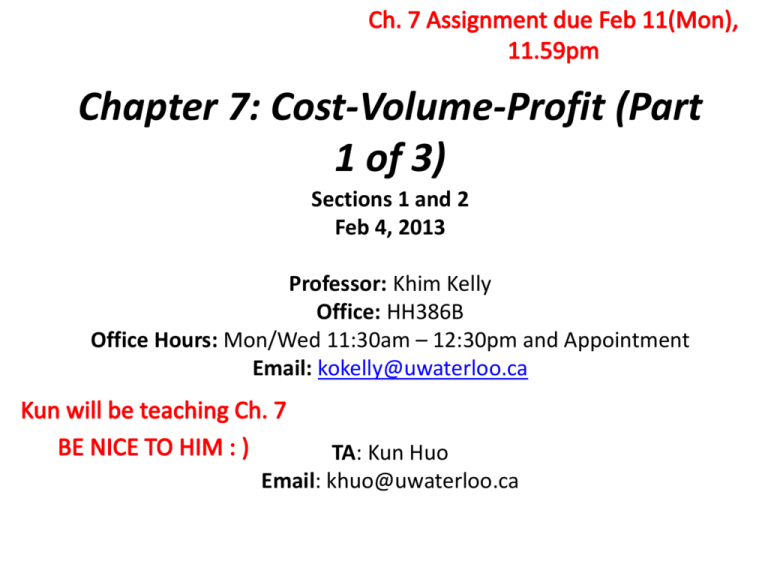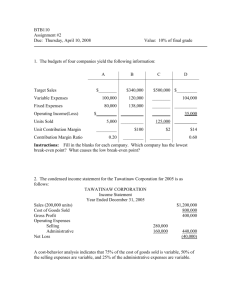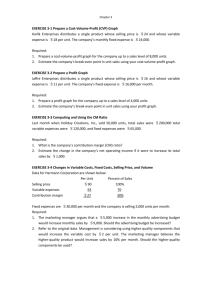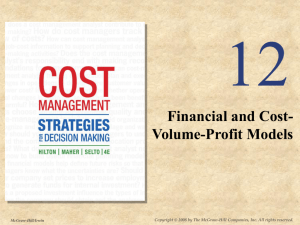AFM102_2013_Feb4_BeforeClass
advertisement

Chapter 7: Cost-Volume-Profit (Part 1 of 3) Sections 1 and 2 Feb 4, 2013 Professor: Khim Kelly Office: HH386B Office Hours: Mon/Wed 11:30am – 12:30pm and Appointment Email: kokelly@uwaterloo.ca TA: Kun Huo Email: khuo@uwaterloo.ca 4 Feb 2013 Overview • Last lecture – Completed Chapter 6 (Cost Behavior) • Today’s lecture … – Basics of Chapter 7 – CM Ratio – Break even Analysis 2 Cost-Volume-Profit • Uses … – – – – Breakeven analysis Scenario analysis (i.e. change in inputs) Cost structure planning and leverage Indifference calculations • CVP considers how income is affected by: – – – – – Prices of products (i.e. sales price) Variable costs per unit Total fixed cost Volume or level of activity (‘X’) Mix of products sold Contribution Margin • CM is used to cover fixed costs, THEN anything left is profit • Profit = Sales – Variable Costs – Fixed Costs CM Contribution Margin • • • • Sales price per unit: $100 Variable cost per unit: $50 Fixed costs: $500,000 What would the operating income (loss) be if: – 0 units produced? Operating loss = CM – FC = Sales – VC – FC = $0 – $0 - $500,000 = ($500,000) – 1 unit produced? Operating loss = CM – FC = Sales – VC – FC = $100 – $50 - $500,000 = ($499,950) – 10,000 units produced? Operating loss = ???? Break-even Point • Break-even point is … – The level of sales at which profit = 0 – Also known as the point where total sales = total expenses or where total contribution margin = fixed expenses Break-even point: Profit = Sales – Variable Costs – Fixed Costs = $0 CM – Fixed Cost = $0 Total Expenses … $ Total Expenses Variable Expenses Fixed Expenses Activity CVP Relationships in Graphical Form Total Sales Revenue $ Total Expenses As long as Contribution Margin > 0 Activity CVP Relationships in Graphical Form Total Sales Revenue $ Total Expenses Activity Contribution Margin Ratio • CM ratio … – Contribution margin (Sales less Variable Expenses) as a percentage of total sales (say 40%) – For every $1 of sales increase, CM will increase by $0.40 – The effect on operating income of any dollar change in total sales can be computed by applying the CM ratio to the dollar change CM Ratio = Total CM Total Sales = Total CM per unit Total Sales per unit Change in op income = Change in sales x CM Ratio It is Clicker Time!! Feel Free to Work Together on Clicker Questions Clicker Question #1 Q: Dillon’s (Khim’s son) garage band – Tone Death – sold out 40 concerts in Khim’s basement, had total revenue of $3000, variable expenses of $2400, and total fixed expenses of $450. What is the band’s contribution margin ratio? A. B. C. D. E. 25% $600 20% $150 Ozzy Osbourne Clicker Question #2 Q: Dillon’s garage band – Tone Death – sold out 40 concerts, had total revenue of $3,000, variable expenses of $2,400, and total fixed expenses of $450. Estimate the change in the band’s income if total sales increased by $1,500 to a total of $4,500 (i.e., Khim forced all her AFM102 students to buy tickets)? A. B. C. D. E. ($150) $300 ($5,012.62) $150 $450 Clicker Question #3 Q: Acoustic is selling 400 speakers per month @ $250 per speaker for total monthly sales of $100,000. Current variable costs are $60,000 and current fixed costs are $35,000. Financially speaking, should they increase sales by $30,000 by increasing fixed costs (advertising) by $10,000? A. Yes B. No Example: Application of CVP Solution 1: CM Ratio [(100k – 60k)/100k] 40% Expected CM with new advertising $52K (130K*40%) Current CM (100K*40%) $40K Incremental CM $12K Change in Fixed Costs ($10K) Change in Operating Income $2K Example: Application of CVP Solution 2 (incremental approach): Incremental CM (30K*40%) Change in Fixed Costs Change in Operating Income • • $12K ($10K) $2K Incremental analysis focuses only on the items that will change as a result of a decision. In general, if a change result in Increase in CM > Increase in fixed costs [or Decrease in CM < Decrease in fixed costs], then the change should be made Change VC + Target Profit (P7-27) You manufacture skateboards that sell for $37.50. Rely on direct labour workers and variable costs are $22.50 per board. In the last year you sold 40,000 boards: Q. Increase of $3 in labour per board expected. How many boards do you need to make to earn the same Op. Income? Income Statement Sales VC CM FC Op. Income Before: 1,500,000 Old Unit CM = $37.50 – $22.50 = $15 $15*40,000 - $480,000 = $120,000 900,000 $600,000 Now (Increase in VC): 480,000 $120,000 17 Change VC + Target Profit (P7-27) Alternatively: FC is not a differential cost (see pg. 47). Therefore, the simplest way is to make the CM of both options equal. Income Statement Sales VC CM FC Op. Income 1,500,000 900,000 $600,000 480,000 $120,000 Before: Old CM = $15*40,000 Now (Increase in VC): New CM = $12*X CM equivalence: 18 Change VC + CM Ratio (P7-27) You manufacture skateboards that sell for $37.50. Rely on direct labour workers and variable costs are $22.50 per board. In the last year you sold 40,000 boards: Q. Increase of $3 in labour per board expected. What is the sales price for the same CM Ratio? Income Statement Sales VC CM FC Op. Inc. Before: CM Ratio = $600,000/$1,500,000 = 40% 1,500,000 900,000 Now (Increase in VC): $600,000 480,000 $120,000 19 Shift to FC from VC (P7-27) You manufacture skateboards that sell for $37.50. Rely on direct labour workers and variable costs are $22.50 per board. In the last year you sold 40,000 boards: Q. Should you automate your manufacturing? This results in VC to decrease 40% and FC to increase 90%. How many units (X) do we need to earn the same Op. Income? Income Statement Income Statement Sales VC CM FC Op. Inc. 1,500,000 900,000 $600,000 480,000 $120,000 Sales VC CM FC Op. Inc. $37.50X ($22.5*0.6)X $24.00X $480,000 * 1.9 $120,000 20 Shift to FC from VC (P7-27) Op. Inc = CM – FC Income Statement Sales VC CM FC Op. Inc. 1,500,000 900,000 $600,000 480,000 $120,000 Income Statement Sales VC CM FC Op. Inc. $37.50X $13.50X $24.00X $912,000 $120,000 21 Important points • Use the formula flexibly – Income = Sales – VC – FC – Income = Units sold * price – units sold * VC per unit – FC – Income = Units sold * (price – VC per unit) – FC • We test you by changing any of the variables but the concept remains the same! • Make sure you identify the variable of interest first • Buy Dillion’s concert tickets, circa 2025, spaces are limited! Summary • Today’s lecture … – Basics of CVP – Contribution Margin ratio – Break even analysis • Next lecture … – More break even analysis – Margin of safety analysis – Target operating profit analysis





